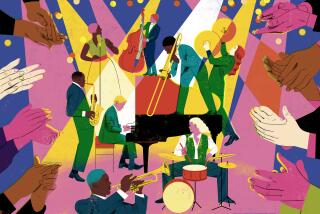A-Plus Goes to B Sharp at System M : Jazz: The quartet just seems to get better, adding intensity to Long Beach club’s intimate setting as crowd focuses on every sound.
LONG BEACH — The last time we saw the B Sharp Jazz Quartet was in August, opening for fusion keyboard player Bobby Lyle at the Hyatt Newporter Hotel’s outdoor amphitheater in Newport Beach. Drawing selections mostly from its eponymous first album, the quartet was wonderful, and though the set was short, it badly upstaged the headliner’s. How could the foursome improve on that?
Well, Saturday at System M, improve the foursome did, adding an extra degree of intensity in the club’s more intimate setting. Indeed, the much-debated question came to mind once more: Is jazz better suited to clubs or to concerts?
Supporters of concerts will tell you that despite the proximity of band to crowd, club patrons tend to talk through performances, creating a distraction one normally doesn’t find in the concert format.
But talking wasn’t a problem at System M. Even in the back of the packed room, people were focused on B Sharp’s every sound, and the group responded very strongly with a varied program that featured each member in turn.
Though the intensity of the compositions seemed to diminish as the set progressed--introspective moments came to replace the high-anxiety freneticism of the first few tunes--the audience didn’t let go but hung tightly to the band’s changing mood.
Saxophonist Randall Willis got the proceedings off on the good foot, blowing muscular tenor on Horace Silver’s “Filthy McNasty,” building lines like an angry discourse into shouts and chest-beating wails before slipping back into the theme line.
Willis shone throughout the proceedings, adding just the right touches of strength and intellect, taking cues from the rhythm section when improvising and making sure his phrases followed in logical progression.
But it was bassist Reggie Carson and drummer/band leader Herb Graham Jr. who took home the most valuable player awards. The BSJQ does its best work on such funk-flavored tunes as “Filthy McNasty” and Willis’ “Almost Next,” and it’s because of Carson’s solid bottom-end sound that these beat-minded numbers succeed. Add Graham’s insightful timekeeping to the foundation and you can build something that would keep standing during The Big One.
Carson was especially agile Saturday, helped by amplification that let each tone stand on its own. Never content just to walk the bass through a song, he matches a tune’s theme in note-for-note unison, or with a well-chosen harmonic blend that adds depth as well as beauty to the line. Behind the saxophone, he listens and responds, taking off from the horn’s statement while filling in with echoes, pops and two-toned doublestops.
Graham is likewise an all-ears player, ready to add emphasis and accent while keeping the clock ticking. At one point during his own “How’s That?,” he produced a dynamic progression of drum rolls behind a repeated saxophone figure that prompted the crowd to erupt in cheers. Such excitement isn’t easy to find in this reserved day and age.
Eliot Douglass’ efforts on piano were hurt by weak amplification on the first number and a piano that badly needed tuning below middle C--a difficulty managed to overcome in a lengthy introduction to his own “The Ascension,” a subtle climb through a lush landscape that showcased his thoughtful, Bill Evans-influenced style.
Douglass soloed with authority during “Filthy McNasty” and added a distinctive bump-and-grind flavor to “Father Knows This Best.” In accompaniment, he provided a wide range of harmonic complements without cluttering anyone’s solo.
Such teamwork is a large part of the reason why B Sharp stands head and shoulders above most of the young bands exploring the post-bop tradition. These guys work together as a unit; there is no clash of egos here. They also write music that fits the teamwork ideal, with each part contributing to a larger whole, rather than taking the usual find-a-groove-and-blow approach of so many emerging jazz figures.
Also in their favor: They extend the musical tradition, they don’t just copy it. Even many of today’s big name musicians are content to re-create the sounds of the ‘50s and ‘60s, but B Sharp puts a decidedly modern spin on its material, even though it springs from the period of Silver, Art Blakey and John Coltrane. Dare we say it? B Sharp is just plain sharper than most of the bands out there today.
More to Read
The biggest entertainment stories
Get our big stories about Hollywood, film, television, music, arts, culture and more right in your inbox as soon as they publish.
You may occasionally receive promotional content from the Los Angeles Times.










